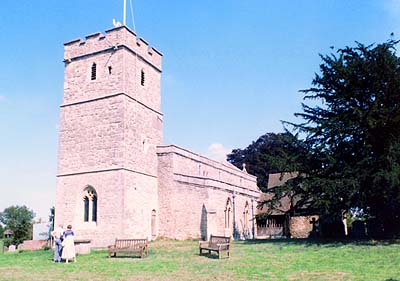
RBH Home
Maps & Travels
Articles
Legends
Towns & Villages
Castles & Houses
Churches
Biographies
Gentry
Family History
Odds & Ends
Mail David
 Long
LongWittenham
St. Mary's Church
St. Birinus himself is supposed to have preached the gospel in Long Wittenham, from the village cross whose base is said to date from the 7th century. The church was presumably founded at the same time.
The present church was built in about 1120 and the nave dates from this time, though the internal arcading and foliate capitals is later. The south aisle was added in the late 12th century and dedicated to St. Thomas of Canterbury who had only recently been canonized. The south chapel was built around 1300, the north aisle in 1340 and the tower in 1430. The chancel was rebuilt in 1850. The 13th century open timberwork porch is said to have come from Lincoln Cathedral.
The south chapel was put up by Princess Joan (of Acre) to the memory of her husband, Gilbert de Clare, the Earl of Gloucester, who was also lord of the manor and died in 1295. It is fitted with the most extraordinary piscina featuring the smallest sculpted monument in the country. Gilbert is shown as a tiny crossed-legged knight at its base, with two angels hovering above him at the apex of the recess. It may have been intended as a heart burial monument, since the rest of his body lies in Tewkesbury Abbey (Gloucestershire). The tomb recess by the chancel arch may also be his. The finely carved south chapel screen and poppy-head choir stalls, showing grotesques and mythical beasts are 16th century. However, they have only stood in the church since the 1870s and 80s, after having been acquired from the chapel of Exeter College in Oxford. The college has been the church's patron since 1322.
The
remarkable font is one of only three lead fonts in the county. It dates
from the 12th century and is embossed with decorative discs and thirty
little archbishops with croziers standing under arcading. During the Civil
War it was encased in wood to stop Roundhead soldiers melting it down for
bullets. Its existence was completely forgotten until 1839, when the wood
was finally removed. The font cover is made from Jacobean panels which
match the pulpit. They were once its sounding board!
